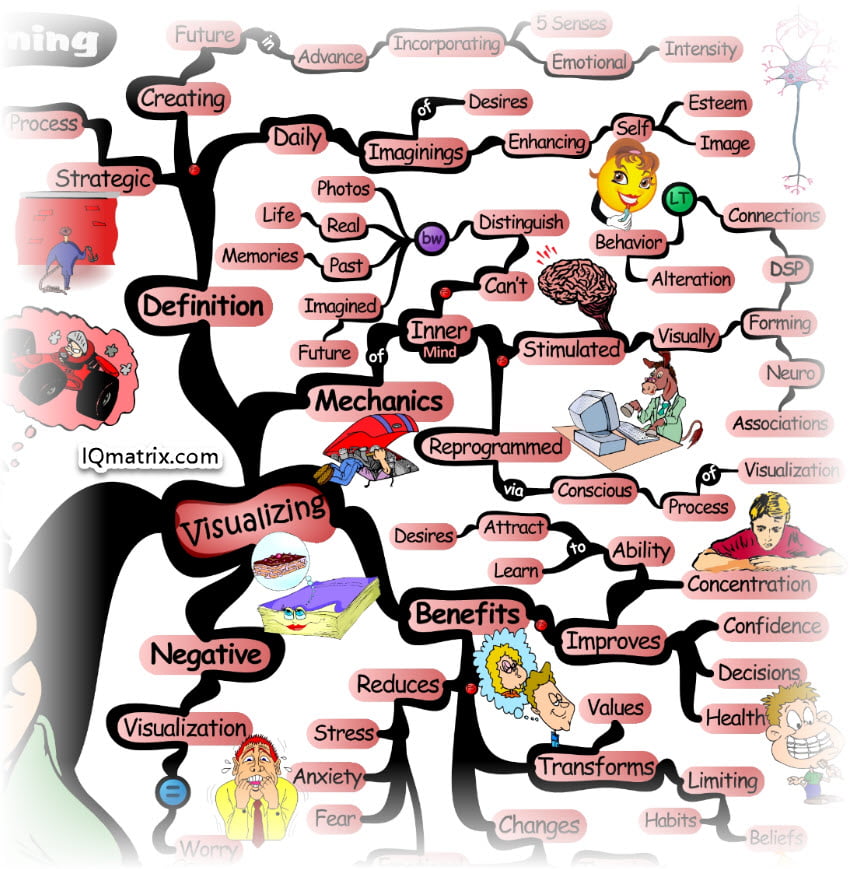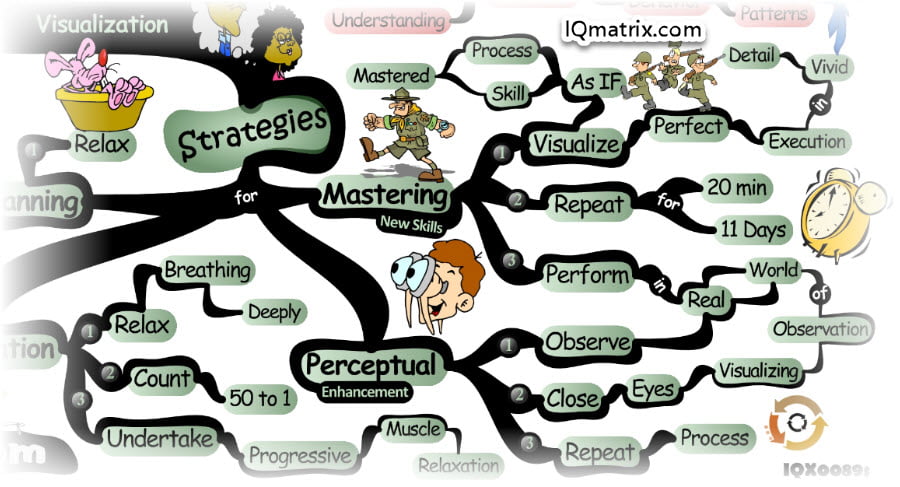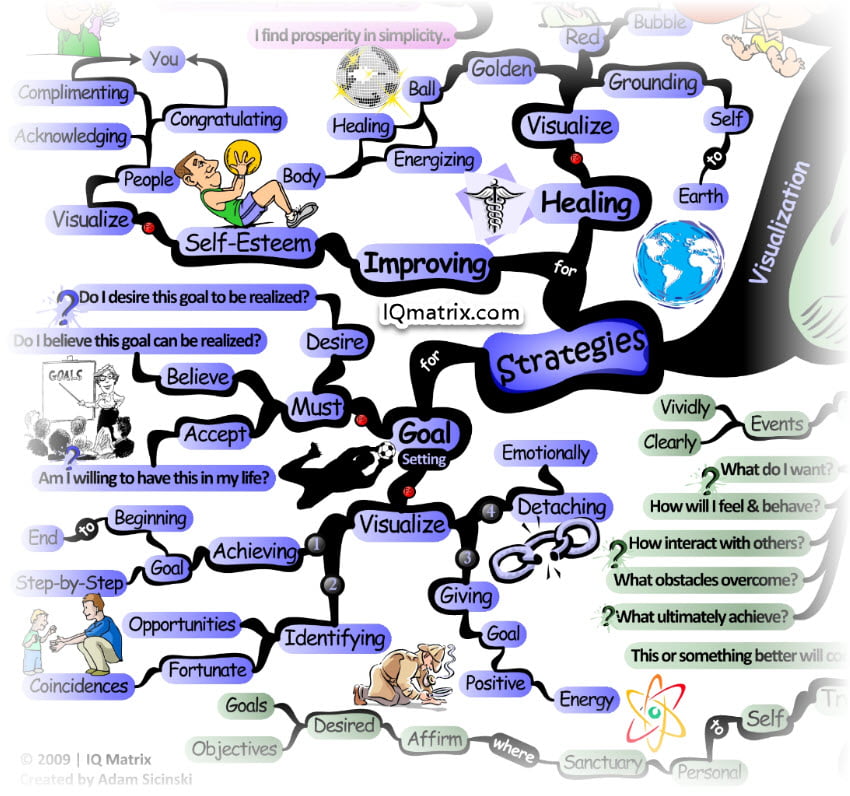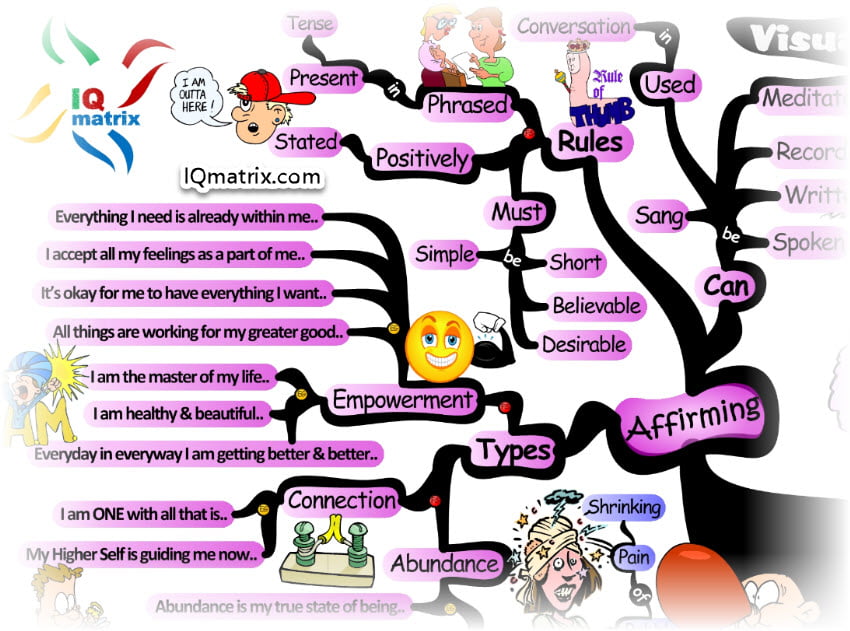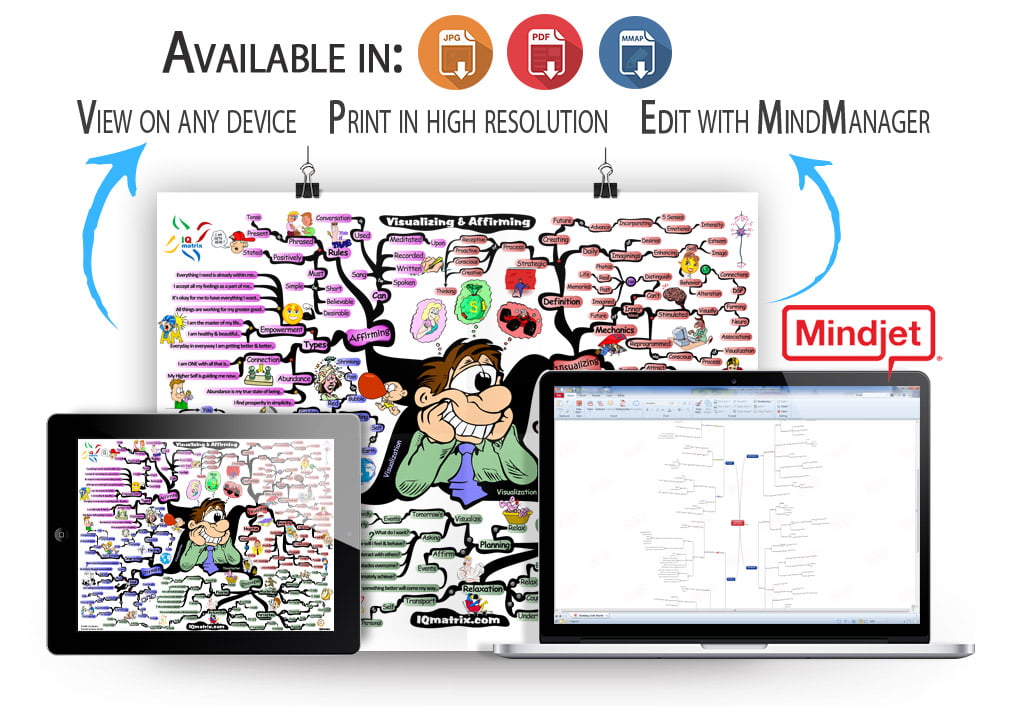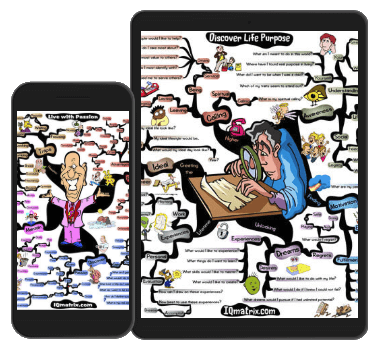To accomplish great things we must first dream, then visualize, then plan… believe… act! – Alfred A. Montapert
Visualization: The Road to Inner Transformation
Have you ever tried visualizing a goal? Or how about visualizing a desired future event? For a great many people visualization is simply a process where we create our future in advance in our mind’s eye. However, visualization is also so much more than this.
Visualization is an inner transformation that leads to the realization of outer results in the real world. It’s very much a creative form of thinking and/or imagining where you consciously create and shape your life with purpose. It’s akin to our very own movie-making studio where we as the Director hold the power to manifest a world of our own choosing. And the best part is that this inner world doesn’t rely upon events of the outer world. In fact, it’s only dependent on the power of your own imagination.
Within this inner world, you can be anything or anyone you choose. No matter what’s happening externally makes no difference to the conscious process of visualization. However, let’s not get this wrong. Visualization isn’t some silly fantasy. This is a conscious and proactive activity where you actively visualize things in a very specific and certain way in order to positively impact your external world. Visualization is therefore very much connected to the real world you live in, however, it’s not dependent upon that world. Although it could be said that how you are within the outer world is in many ways dependent on the internal world you create for yourself each and every day.
Visualization Holds the Key to Improved Performance
Did you know that visualizing a skill or action in advance is almost as powerful as physically performing that action?
Brain studies have revealed that our thoughts actually produce the same mental instructions as actions. What this means is that how we mentally rehearse something in our minds (through the process of visualization) impacts many cognitive processes in the brain including motor control, attention perception, planning, and memory. In other words, your brain is stimulated in exactly the same way when you’re physically performing an action as when you’re visualizing that same action. Therefore visualization provides the same value as the physical act of doing something.
While visualizing, your conscious brain is of course very much aware that what you’re doing isn’t real and is just a creation of your imagination. However, your inner mind (subconscious) actually doesn’t distinguish the difference between what you think and what you physically do. In other words, your inner mind doesn’t know the difference between what’s a photo, what’s real life, what’s a past memory, and/or what’s an imagined future. It instead takes everything as being real.
These results are evident in brain scans that show there is no difference in brain activity when a person is visualizing compared to when a person is observing something in the real world.
All this is of course incredibly significant because it means that through the act of visualization we can not only learn new skills, but we can effectively rewire and reprogram our brain without needing to perform the physical actions in the real world. What this effectively means is that if for instance, you struggle with low self-esteem, then you can actively work on building your self-esteem in your imagination through the process of visualization before taking those same actions in the physical world.
Building your self-esteem in this way is very helpful because it minimizes feelings of anxiety. Working through scenarios in your mind — where you typically struggle with low self-esteem — can help you to effectively reprogram your brain and create new habits and patterns of behavior that will make venturing into the real world far less anxiety driven. As such, you will feel calmer and at ease when it comes time to bring your visualizations to life.
For more information about visualization and its impact on the brain, please see:
- Seeing is Believing: The Power of Visualization
- From Mental Power to Muscle Power: Gaining Strength by Using the Mind
- Visualize It: The Technique Used to Win the Game, Get Rich and Fight Illness
- Does Visualization Really Work? Here’s Evidence that it Does!
More links and resources provided at the end of this article.
17 Ways to Use Visualization to Enhance Your Life
The true value of visualization, of course, goes well beyond simply boosting our levels of performance. Visualization can, in fact, be used in a variety of ways to improve many areas of your life. For instance, it can be used to:
- Achieve your goals
- Improve learning ability
- Enhance concentration
- Enhance self-esteem
- Boost self-confidence
- Improve decision-making
- Enhance physical health
- Transform values
- Eliminate unhelpful habits
- Reprogram limiting beliefs
- Improve planning
- Master a new skill
- Change habitual thinking patterns
- Enhance emotional awareness
- Improve observation skills
- Heal the body and settle the mind
- Reduce impact of stress, anxiety, and fear
A little later in this article, we will explore visualization techniques you can use to help enhance some of these areas. However, as great as visualization is, and the incredible value it can bring into our lives, there is, however, another unconscious form of visualization that we all tend to indulge in — from time-to-time — that isn’t very helpful.
How Your Worries are Rewiring Your Brain
Experiencing stress, anxiety, fear or worry is actually a form of negative visualization. Yes, it’s very much an unconscious form of visualization where we’re not quite aware of what we are doing; but it’s visualization nevertheless.
Every time you stress or worry about something, suffer from bouts of anxiety, or fear what might happen in the future, you are at that moment visualizing negative events, or in other words: The things you don’t want.
What’s more, you are actually at that moment rewiring your brain in very limiting ways. Just as the brain can be rewired to build helpful and empowering habits, it can also be programmed in unhelpful ways.
Every time you indulge in your worries you are at that moment building upon existing neural pathways in your brain. As such, each time you visualize something negative you make it easier to worry about these things in the future. Your visualization of negative events in your mind’s eye is making you feel uneasy in the present moment.
What’s worse is that your subconscious mind doesn’t understand the difference between what you see and what you visualize. As such, it interprets these events as actually happening in the real world, which results in the formation of neural networks in your brain that builds new perspectives, beliefs, and habits of behavior. In other words, you are effectively hardwiring your brain with new patterns that support everything that you’re worrying about.
What you’re doing here is effectively building a skill (pattern of behavior) that isn’t helpful. And the more times you run this pattern through your mind the easier it is to replay that pattern over-and-over again until worrying just becomes a habitual response whenever you face any level of uncertainty.
What’s more, is that the things you worry about are more likely to manifest in your life. This occurs because what you focus on expands in your life through the stimulation of the Reticular Activating System. Your brain is now looking for anything it can find within your environment that supports your worries. As such, everything you see now validates what you’ve been worrying about. Subsequently, you make poor choices and decisions based on this flawed perspective, which can often lead to the manifestation of your worries in the real world.
Yes, all this sounds quite remarkable, but the exact same process is at play when you visualize a goal that you would like to achieve. This then initializes the Reticular Activating System, which effectively helps you become more aware of people, events, and opportunities related to your goal. Subsequently, this leads to making choices and decisions based on this information, which of course can help you to effectively achieve this goal in the real world.
Given all this, visualization can, therefore, be used in a helpful and empowering way, but it can also be used in an unhelpful and limiting way. The choice is, of course, yours to make. 🙂
Seven Life Enhancing Visualization Techniques Explained
Within this section, let’s take a look at seven visualization techniques you can use to help improve certain aspects of your life, including:
- Mastering a new skill
- Enhancing your perceptions
- Improving your self-esteem
- Relaxing your body and mind
- Healing your body and mind
- Outlining a plan of action
- Achieving your goals
Let’s outline a process of steps that you can follow for each area while also briefly discussing how using each visualization can be of value.
Mastering a New Skill
The first way you can use visualization is to master a new skill area. Visualization can be quite effective in this instance because the human brain is stimulated in exactly the same way when we visualize as when we physically perform that skill.
Take for example a study conducted by Australian psychologist Alan Richardson who tested the power of visualization on a person’s ability to shoot free throws. Free throws are a basketball term where a player shoots a penalty shot from the free throw line after getting fouled.
Richardson chose three groups of students at random. None had ever practiced visualization. The first group practiced free throws every day for 20 days. The second made free throws on the first day and the twentieth day, as did the third group. But members of the third group spent 20 minutes every day visualizing free throws. If they “missed,” they “practiced” getting the next shot right.
On the twentieth day Richardson measured the percentage of improvement in each group. The group that practiced daily improved 24 percent. The second group, unsurprisingly, improved not at all. The third group, which had physically practiced no more than the second, did 23 percent better—almost as well as the first group!
In his paper on the experiment, published in Research Quarterly, Richardson wrote that the most effective visualization occurs when the visualizer feels and sees what he is doing. In other words, the visualizers in the basketball experiment “felt” the ball in their hands and “heard” it bounce, in addition to “seeing” it go through the hoop. [source]
You can, of course, use this visualization technique to master any skill you are wanting to learn, however, it is important — as Richardson suggested — that you utilize all your senses while visualizing yourself performing this skill.
Here are five steps to make this visualization work for you:
- Step 1: Pick a skill that you would like to master.
- Step 2: Determine your real-world level of proficiency in executing this skill.
- Step 3: Visualize yourself executing this skill in vivid detail using all your senses.
- Step 4: Repeat this visualization process for 20 minutes per day for at least 11 days.
- Step 5: Perform this skill in the real world and measure your improvement. If you’re not satisfied with the results, then continue visualizing while also executing this skill in the real world.
Enhancing Your Perceptions
Visualization can also be quite effective in helping you enhance your perceptive awareness and observation skills. This is of tremendous value as it can help improve your awareness of people and of the situations you find yourself in. Moreover, it will help enhance your memory and recall of your environment.
Here are three steps to make this visualization work for you:
Step 1
Sit in a quiet place and spend a few minutes simply observing your surroundings.
Step 2
Now close your eyes and recreate those surroundings in as much detail as possible in your mind’s eye. Make sure that you pay particular attention to the fine details, colors, and textures of everything that you observed within the first step.
Step 3
Repeat the process until you can remember and recall every detail of your surroundings.
Performing this visualization daily will help you become much more aware of the fine details around you while you go about your day.
Another variation of this visualization technique is to spend 15 to 20 minutes at the end of your day recalling your entire day from the time you woke up till this present moment. This is one of the most effective ways to help improve your long-term memory and recall.
Improving Your Self-Esteem
Whether you’re lacking in confidence or simply experience bouts of low self-esteem, you can use visualization as an effective tool to help you feel better about yourself, and thereby more competent and capable in the real world.
Here are three steps to make this visualization work for you:
Step 1
Close your eyes and imagine standing in a large empty room.
Step 2
One-by-one visualize someone you personally know entering this room. They walk up to you and either congratulate you, compliment you or acknowledge your work and efforts.
Step 3
Once the room is full of people, visualize yourself mingling with everyone and talking about your accomplishments. Be sure to thank them for their support and valuable feedback.
You can, of course, modify this visualization technique to include role models or mentors. You can also visualize people giving speeches about how much they appreciate and value you. 🙂 And of course, this is all about the little things. For you, it might not be about the huge accomplishments, but rather about the small and seemingly insignificant things that make you who you are. It is these things that should be acknowledged.
Building up your self-esteem isn’t a quick process, however, visualizations such as this — for 10 to 20 minutes per day — can progressively help you find more confidence within yourself to do the things you feel you can’t do in the real world. All you need to do is simply start the ball rolling so that you can begin building momentum. And this simple visualization can do that for you. 🙂
Relaxing Your Body and Mind
Visualization can be used quite effectively whenever you are under intense pressure or heavy stress. In fact, whenever you experience a difficult emotion, you can use visualization to help calm your body and mind.
Here are three steps to make this visualization work for you:
Step 1
Sit or lie down in a quiet place where there are no distractions. You can even play some tranquil music in the background to help you settle down into a deep state of relaxation.
Step 2
Breathe deeply and count backward from 50 to 1. As you make this count, start progressively relaxing every muscle in your body from head to toe.
Step 3
Once fully relaxed, transport yourself in your mind’s eye to a personal sanctuary. There you find everything that makes you feel calm, serene and happy.
Once you’re within this personal sanctuary you can take this visualization in a number of directions. For starters, you can simply just enjoy the peace and harmony of the moment. Or you can potentially use this place to affirm your goals, objectives, values, and priorities. Or potentially, maybe a mentor awaits you there. Use this time to chat with them about your problems and potential solutions for resolving them.
There are many possibilities here. Your personal sanctuary visualization can be used in numerous ways, and you can transport yourself there anytime you need some balance, peace, harmony or guidance.
Healing Your Body and Mind
Over the years science has shown that there is a strong connection between the body and mind. In fact, we see this connection in many scientific studies where placebos are used instead of the actual medication. In such instances, people who receive the placebo believe that they are being administered the medication. And what’s interesting is that time and again these studies have shown that placebos work just as well as the actual medication.
So what’s actually happening here?
Essentially what’s going on is that we convince ourselves that something is supposed to help us (a belief system), and then, as a result, the brain releases corresponding chemicals and neurotransmitters that activate the healing process.
We must also of course talk about the Nocebo Effect. This is where a patient receives a “sugar pill” — thinking it’s the actual medication — and as a result, they end up feeling worse and experiencing symptoms of the supposed drug. Again our brains and our belief systems are at play here creating this effect.
To find out more, please have a read of The Placebo Phenomenon and The Nocebo Effect.
All this is of course quite relevant for visualization and how it can be used to help heal your body. Visualization is very much like the placebo in the above example. However, the process of visualization potentially has much deeper effects.
When you visualize the process of healing you are actually sending powerful messages to your brain instructing it to produce chemical compounds to help activate the healing process. The problem here is that you also need to back this visualization with strong self-belief that you can make this process work. And that’s never a guarantee. However, with the way these visualizations work; by simply focusing your visualization on your body in a specific way helps focus your energy, which can effectively initiate the process of healing.
There’s a lot that could be said on this subject. If you want to find out more, I would recommend reading the article: The Science Behind Guided Imagery. It’s, of course, a very controversial topic that doesn’t yet have any definitive answers. However, that doesn’t mean that using visualization for healing purposes won’t work for you. It can at the very least help calm your body, mind, and spirit.
I want to specifically focus on three ways of using visualization for healing purposes.
The Earth Energy Visualization
The first technique simply involves closing your eyes (while sitting or standing) and grounding yourself to the earth. Visualize the energy of the earth passing through you and healing your body. You can also perform this visualization by holding onto a large tree trunk and drawing upon its energy.
The Golden Ball Visualization
The second technique involves sitting in a quiet place and visualizing a golden ball of energy or light surrounding your body. This energy starts as a small speck within your heart chakra and then with every breath you take it progressively grows and expands until it envelops your entire body. That’s where you begin to feel its healing properties working through your body and circulating through your veins.
The Fireball Visualization
The third technique is used for the purposes of helping you manage pain more effectively. Here you sit quietly with your eyes closed and begin focusing on an area of your body where you feel discomfort or pain. Visualize this area as a big, bright and red fireball. Then progressively, with every breath, the fireball grows smaller and smaller until it becomes a small speck on your body. And of course, as the fireball shrinks imagine your pain dulling or melting away like the snow on a warm spring day.
You can, of course, use each of these techniques in combination, or creatively explore other visualization methods for dulling pain and/or for healing purposes. There are certainly many possibilities here that you could explore. With practice, you will find a method that feels most comfortable and works best for you.
Outlining a Plan of Action
If ever you find yourself feeling overwhelmed or stressed, then using visualization to layout a plan of action can help you to calm down, stay centered and begin taking proactive action.
The technique is best used at the end of your day to help you plan the following day’s work. However, it can also be used throughout the day when you have about 10 minutes to spare.
Here are three steps to make this visualization work for you:
Step 1
Calm yourself down and just relax. Sitting down is probably a good idea as it will help you to mentally take a break from what you were doing.
Step 2
Close your eyes and begin visualizing exactly what you would like to accomplish for the remainder of the day (or for tomorrow). Visualize everything you will do in detail and ask yourself the following questions:
What do I want?
How do I want to feel?
What specific actions do I want to take?
How will I interact with other people?
What obstacles will I potentially need to overcome?
How will I overcome these obstacles?
What do I ultimately want to achieve?
It’s important that you fully visualize your answers to these questions. Don’t just settle for the first answer the comes to mind. Actually, see yourself vividly going through each response. Only in this way will you experience things fully and will see your circumstances more clearly.
Step 3
The reality of life is that we are unfortunately unable to predict everything that happens to us. When unexpected events happen they can often ruin our plans. However, good planning isn’t about being stringent. It’s rather about adapting to the circumstances life hands you. With this in mind, it’s therefore important to affirm at the conclusion of the visualization that:
This or something better will come my way.
By affirming this you are keeping your mind open to the possibilities. As a result, you will be far more ready and willing to make adjustments when unexpected situations come your way.
No, this process certainly doesn’t bring about a foolproof plan, however, what this visualization helps you to do is to envision possible scenarios that might take place. Having these scenarios in mind allows you to make better choices and decisions as you work on your projects and tasks.
Achieving Your Goals
The final visualization technique that I want to discuss here involves the process of goal setting.
Using visualization for goal setting purposes can be of tremendous value, however, the technique also comes with one major drawback.
Goal setting is probably the most popular form of visualization. A great many people have at one time or another visualized their goals. But unfortunately for most, this technique simply hasn’t worked because of one major critical flaw.
When most people visualize their goals they only visualize the end-goal. They see in their mind’s eye this big, flashy and wonderful goal at the end of their journey. And yes, they also experience it fully using all their sensory awareness. This is all of course wonderful. They open their eyes and walk away from the visualization feeling extremely motivated. However, this motivation is fleeting as the very next obstacle or challenge they face immediately deflates their ego.
They then feel as though they need to visualize their goal again to once more spark that motivation. However, each time they visualize their goal nothing happens. The motivation doesn’t get any stronger, their hunger for this goal doesn’t get any larger. In fact, each time they hit a roadblock and revert back to the process of visualization, their motivation weakens and they begin to lose more focus and energy as time moves on.
So what exactly are these people doing wrong?
What these people are doing wrong is that they are not visualizing their goal in the right way. For them, they only see the destination, however, a goal is so much more than that. Reaching a goal involves a journey of ups and downs, of wins and losses, and of emotional highs and lows. And as such, these are exactly the kind of things you need to include in your visualization.
Yes, of course, visualize the end goal to create that hunger and desire. However, spend only 10 percent of your time visualizing the destination. Spend the remainder of your visualization imagining how you will achieve that goal and the obstacles, setbacks, challenges, and problems you will overcome in the process. In ways, it’s a form of visual planning.
Your end-goal will help keep you inspired long-term, however, it’s the journey that needs to keep you motivated in the short-term. And it’s exactly this journey that you must visualize in order to maximize the time you spend on this process.
Here are five steps to make this visualization work for you:
Step 1
Sit in a quiet place with your eyes closed. Now begin to visualize your end goal. See yourself living and experiencing this goal with all your senses.
Step 2
Progressively step back in time from your end goal and visualize the process you undertook that helped you achieve that goal. Envision all the obstacles you faced and the setbacks that held you back, but clearly see yourself successfully overcoming them. Keep visualizing all the way back to the present moment.
Step 3
Now move forward in time and visualize how you took advantage of opportunities and how fortunate coincidences helped you overcome each obstacle. See as clearly as possible how things unfolded for you.
Step 4
At the conclusion of your visualization take time to send the future “you” positive energy for the journey ahead.
Step 5
As you come out of the visualization immediately detach yourself emotionally from the outcome. The one thing that can hold you back is an emotional attachment to a specific result. Instead, stay open and flexible for the journey ahead. Sometimes you won’t get what you want, but will rather end up getting something better that involves a lot more work. 🙂
You can visualize your goals in this way daily or weekly. Your weekly sessions can be longer for up to 30 minutes, while your daily sessions can be shorter for about 5 to 10 minutes. However, make sure to focus your daily sessions predominantly on achieving the next steps of your goal for that day or week. This will keep you moving forward. Then you can, of course, focus your weekly visualizations on going through the above five-step process.
Enhancing Visualization Through the Use of Affirmations
One additional method that can effectively enhance the output of your visualizations comes in the form of affirmations.
Affirmations involve repeating words and phrases to yourself that send specific instructions to your body and mind. In other words, your affirmations must send commands that help direct your thoughts and actions throughout the day or during your visualizations.
More specifically, affirmations can be used to help support the daily habits and beliefs that build the foundations of your actions; allowing you to achieve your goals. And this all essentially comes down to talking to yourself with a sense of purpose.
Typically when people think about affirmations they consider it a passive act. And for most people it is. Affirmations such as:
Everything I need is already within me…
I accept all my feelings as part of me…
It’s okay for me to have everything I want…
All things are working for my greater good…
I am the master of my life…
I am healthy and beautiful…
Everyday in everyway I am getting better and better…
I am ONE with all that is…
My higher self is guiding me now…
Abundance is my true state of being…
I find prosperity in simplicity…
These are all, of course, wonderful affirmations. They will make you feel all warm and fuzzy inside. 🙂 However, how effective are they really? Do they inspire you to take positive and proactive action toward your goals?
Affirmations such as these are suitable to use while you’re visualizing. They can help keep you grounded and focused. However, once your visualization is over, you need something more. You need something that will help you bring your visualization into physical reality.
For the purpose of this discussion, let’s focus on the goal setting or planning visualizations we explored within the previous section. These visualizations do a great job of helping you identify what it is you want and also how you will achieve your goal. Your challenge now is to stay focused throughout the day on bringing these visualizations into reality, and this is where affirmations come into the frame. However, I’m of course not suggesting you use the above affirmation examples. These are passive. What you need is “active” affirmations that will help you stay focused and encourage proactive action.
How to Develop Empowering “Actionable” Affirmations
While developing affirmations consider how “actionable” they are in real life scenarios.
You could, for instance, design your affirmations around how you would like to behave throughout the day in order to keep yourself focused on achieving goal-related tasks. Consider for a moment:
What do I want to accomplish and why?
Whom do I need to “be” in order to accomplish my goal?
This is all about designing and developing the mindset required to enhance your life, to overcome limitations and problems, to develop empowering habits, beliefs, and the attitude that it will take to accomplish your goal. And all of these things, of course, come through the affirmations you set into motion that naturally build upon your visualizations.
Typically you will want to build your affirmations upon specific actions that you will take throughout the day to accomplish your goal. You could, for instance, take into account the frequency of the action, the quantity that must be achieved, and any timeframes that must be accounted for. Your affirmation could, therefore, evolve along the following lines:
I am confident in my skills and in my ability to get things done.
I am calling 5 prospects an hour and generating an average of $100 worth of sales per prospect.
Every call I make gets me closer to the $50,000 target I reach by December 31st of this year.
No matter what happens I will stay focused and on track; always moving forward in pursuit of my goal.
As you can see within this example, the first affirmation addresses the level of confidence (belief) I have in my ability to get things done; the second addresses what specific actions I will take to reach my target (habits); the third addresses the big picture timeframe and target I am working toward (goal); while the final affirmation addresses the mindset required to follow through with my actions (attitude).
Now, of course, your priorities, tasks, and activities might change from day-to-day. As such your affirmations should change accordingly. And that’s of course okay. As long as your affirmations are tied to specific actions you take throughout the day and are built upon developing empowering beliefs, habits and an attitude that helps move you closer to your goal, then you will be fine.
It’s important to note that affirmations are however limited in that they don’t allow you to expand your understanding and awareness of a situation. You might, for instance, suffer a setback and subsequently achieving your target might now seem improbable. In such instances, you must step back from blindly repeating affirmations and instead begin asking questions that can help you explore why things are the way they are and how you can get things back on track. Only in this way will you successfully move through the potential problems and challenges that arise.
Affirmations Come in Many Forms
Typically the affirmations you set must be simple, short, believable, actionable and desirable. They must also be positively stated, and where possible phrased in the present tense.
Affirmations, however, don’t necessarily need to come in the form of phrases. You could, for instance, write out your affirmations throughout the day on a piece of paper, or create a song or poem that incorporates some of your empowering and actionable affirmations. Affirmations can also be used in conversation with other people in a very subtle way of course. 🙂
In the end, no matter what structure you choose, it’s important that you always maintain that connection between your visualizations and affirmations. Only in this way will there be continuity that can help you to make the most of the actions you take throughout the day.
Time to Assimilate these Concepts
Did you gain value from this article? Is it important that you know and understand this topic? Would you like to optimize how you think about this topic? Would you like a method for applying these ideas to your life?
If you answered yes to any of these questions, then I’m confident you will gain tremendous value from using the accompanying IQ Matrix for coaching or self-coaching purposes. This mind map provides you with a quick visual overview of the article you just read. The branches, interlinking ideas, and images model how the brain thinks and processes information. It’s kind of like implanting a thought into your brain – an upgrade of sorts that optimizes how you think about these concepts and ideas. 🙂
Recommended IQ Matrix Bundles
If you’re intrigued by the idea of using mind maps for self-improvement then I would like to invite you to become an IQ Matrix Member.
If you’re new to mind mapping or just want to check things out, then register for the Free 12 Month Membership Program. There you will gain access to over 90 mind maps, visual tools, and resources valued at over $500.
If, on the other hand, you want access to an ever-growing library of 100s of visual tools and resources, then check out our Premium Membership Packages. These packages provide you with the ultimate visual reference library for all your personal development needs.
Gain More Knowledge…
Here are some additional links and resources that will help you learn more about this topic:
- Can Visualizing Your Body Doing Something Help You Learn to do it Better? @ Scientific America
- Guided Visualization: A Way to Relax, Reduce Stress, and More! @ Psych Central
- How to Learn Skills Twice as Fast, According to Science @ Inc.
- How to Use Visualization to Get What You Want @ Mind Body Green
- Mental Contrasting Makes You More Successful According to 18 New Studies @ Mindfully Alive
- The Extraordinary Power of Visualizing Success @ Entrepreneur
- The Power of Visualization @ Psych Central
- The Power of Visualization in Manifesting Your Success @ Elite Daily
- The Power of Visualization’s “Aha” Moments @ Harvard Business Review
- This Visualization Technique Helped Me Build a $100M Business @ Inc.
- Visualize Success if You Want to Fail @ Forbes
- Why Visualization Might be the Missing Habit for Your Success @ Huffington Post

